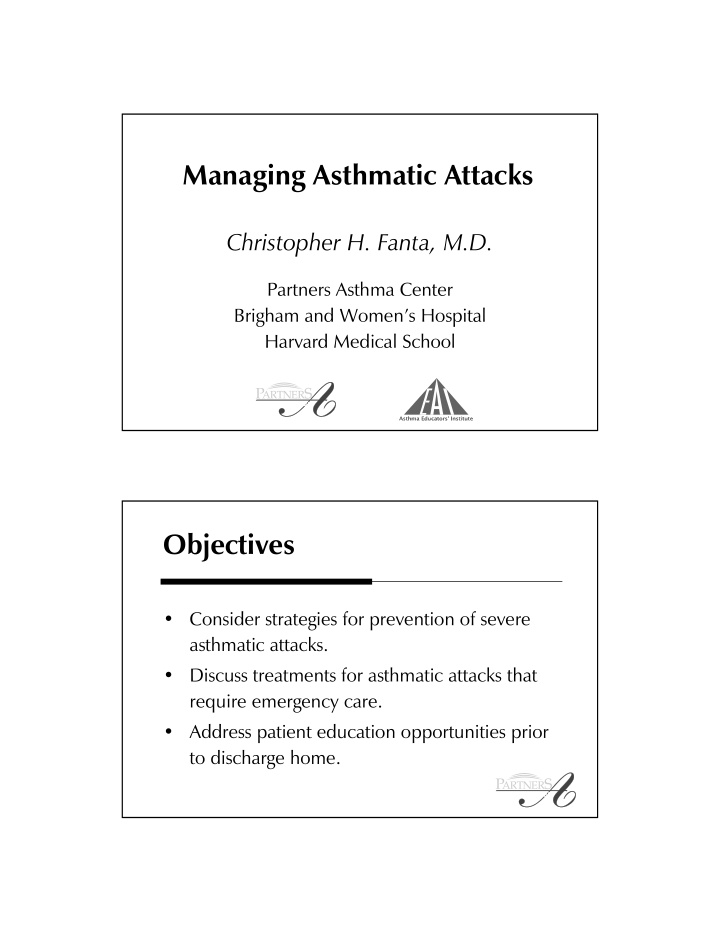



Managing Asthmatic Attacks Christopher H. Fanta, M.D. Partners Asthma Center Brigham and Women’s Hospital Harvard Medical School Objectives • Consider strategies for prevention of severe asthmatic attacks. • Discuss treatments for asthmatic attacks that require emergency care. • Address patient education opportunities prior to discharge home.
Case History: Chief Complaint Five days after developing an upper respiratory infection, a 35-year old woman with long-standing asthma presented to the Emergency Department with severe shortness of breath and wheezing. Case History: Recent History Her 3-year old son and then her husband had come down with similar “colds.” With her illness, she had progressively worsened despite increasing her inhaled budesonide from 4 to 8 inhalations/day. Last night she slept little due to cough and wheezing.
Case History: Physical Exam In the Emergency Department she appeared in respiratory distress. RR 28/min with accessory muscle use. BP 140/70 mm Hg with 20 mm Hg paradoxical pulse. HR 112/min, regular. T 99.1 o F. Chest: diffuse insp. and exp. wheezes. PEFR = 150 L/min (33% of normal). The Best Management Is Prevention “Treatment of status asthmaticus is best started 3 days prior to the attack.” -- Thomas Petty, M.D
Preventive Strategies Early recognition of deterioration Prompt patient-provider communication Written “asthma action” plan Intensification of anti-asthma medications, often including a short course of oral corticosteroids Patient Assessment History Physical exam Peak flow determination (Chest X-ray) (Arterial blood gases)
Principles of Care for Acute Asthma Principal goal: rapid reversal of airflow obstruction Repetitive administration of inhaled beta- agonists (+ ipratropium bromide) Early addition of systemic corticosteroids Correction of hypoxemia Close monitoring, including serial measurements of lung function Treatment of Acute Asthma: Overview Problem Treatment • Bronchoconstriction Frequent inhaled beta-agonist bronchodilator • Airway swelling and Systemic mucus plugging corticosteroids
Initial Treatment Nebulized albuterol 2.5 mg every 20 minutes Alternatives: Albuterol by MDI with spacer 4 puffs every 10 min Continuous nebulization of albuterol Nebulized albuterol 5 mg every 20 min. Nebulized levalbuterol 1.25 mg every 20 min MDI and Nebulizer Equivalence 1.6 FEV 1 (L) MDI (n=27) 1.2 Neb (n=28) 0.8 0.4 0 0 30 60 90 Time (min) 10 Dyspnea (Borg scale) 8 6 4 Turner JR, et al., 2 Chest 1988 0 0 30 60 90 0 30 60 90
Patterns of Response to Albuterol Strauss L, et al. Am J Respir Crit Care Med 1997; 155:454. Additional Bronchodilators in Acute, Severe Asthma Ipratropium bromide Magnesium sulfate 2 gm i.v. over 20 min Additional sympathomimetics Epinephrine 0.3 mg s.c. (Intravenous montelukast)
Steroids in Acute, Severe Asthma Systemic steroids (tablets/liquid, intramuscular, intravenous) speed the resolution of asthma attacks and reduce the likelihood of recurrences (“relapses”). Inhaled steroids begun at the time of ED discharge decrease the likelihood of recurrent attacks.
Oral vs. Intravenous Corticosteroids When given in comparable doses, there is no difference in efficacy between oral and intravenous corticosteroids for acute, severe asthma. Systemic Steroids for Hospitalized Patients Oral prednisone 40 – 80 mg/day Exception: vomiting or other GI intolerance
The Outpatient “Steroid Burst” No specific schedule proven better than another Taper not necessary if treatment continued until lung function has recovered to normal or near-normal Risk of recurrent asthmatic symptoms reduced by use of inhaled steroids The Outpatient “Steroid Burst” One example: prednisone 40 mg/day for 4 days; 30 mg/day for 4 days, 20 mg/day for 4 days; 10 mg/day for 4 days Oral steroids can be administered once daily
Antibiotics for Acute, Severe Asthma Empiric antibiotics of no proven benefit in hospitalized patients with acute attacks Other Therapies of Unproven/Unlikely Benefit Hydration Chest physiotherapy Mucolytics Antihistamines
Controversial Therapies in Acute, Severe Asthma Helium-oxygen gas mixture CPAP/Non-invasive mask ventilation Indications for Intubation and Mechanical Ventilation Respiratory arrest/agonal respirations Acute respiratory acidosis (PCO 2 >55 mm Hg; pH <7.28) in patient: Who is in respiratory distress; Whose PCO2 is rising despite aggressive treatment; or Who cannot or will not cooperate with other therapies
Patients at High-Risk for Severe Attacks On daily prednisone prior to admission >2 E.D. visits in last 6 months >1 prior hosp’ns in last 12 months Ever intubated for asthma Severe psychosocial problems Patient Education Prior to Hospital Discharge Proper use of inhalers Indications for different medications Use of spacers Peak flow monitoring Individualized “asthma action plan” Discussion of environmental control issues
Conclusions • Early intervention (by patients and providers) can often prevent asthmatic attacks from becoming severe. • Key elements of treatment of asthmatic attacks are intensive use of inhaled beta-agonist bronchodilators plus systemic corticosteroids. Conclusions • Peak flow monitoring is useful in assessing the severity of attacks and response to treatment. • An asthmatic attack represents a “teachable moment” for the asthma educator, with opportunities to improve patient understanding and co-management skills.
Recommend
More recommend